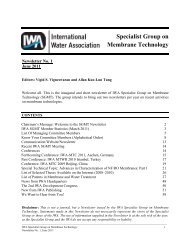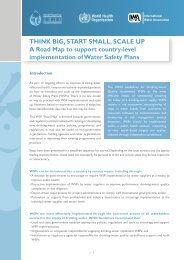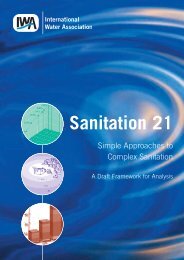AdApting urbAn wAter systems to climAte chAnge - IWA
AdApting urbAn wAter systems to climAte chAnge - IWA
AdApting urbAn wAter systems to climAte chAnge - IWA
You also want an ePaper? Increase the reach of your titles
YUMPU automatically turns print PDFs into web optimized ePapers that Google loves.
36 Adapting urban water <strong>systems</strong> <strong>to</strong> climate change<br />
A handbook for decision makers at the local level<br />
Section 3<br />
Adapting the urban water system: city examples<br />
37<br />
<br />
Adapting the urban water<br />
system: city examples<br />
Section 3 presents highlights from 10 case studies of cities that are seeking <strong>to</strong> adapt<br />
their water system <strong>to</strong> climate change; the case studies themselves are available online on<br />
the handbook’s accompanying website (www.adaptationhandbook.org). The case studies<br />
cover cities in both developed and developing countries: Durban (South Africa), Hanoi<br />
(Vietnam), Infanta and General Nakar (The Philippines), Lima (Peru), London (U.K.),<br />
Melbourne (Australia), New York City (U.S.A), Rotterdam (The Netherlands), Semarang<br />
(Indonesia) and Toron<strong>to</strong> (Canada).<br />
The cities profiled are at different stages of the adaptation process: some have implemented<br />
specific adaptation actions, while the majority have adopted or at least initiated an<br />
adaptation strategy. The case study cities face a variety of climate change challenges, and<br />
their responses are equally diverse. Some prioritise a single type of adaptation response,<br />
such as strengthening governance in Durban or improving infrastructure in Semarang.<br />
Others rely on a portfolio of responses which include the previous two as well as the use<br />
of economic incentives and natural <strong>systems</strong>.<br />
Overall, the city examples provide an ideal illustration of the main concepts outlined in<br />
this handbook. Most place strong emphasis on the importance of involving stakeholders<br />
at all stages of the process and of integrating quality of life considerations in<strong>to</strong> adaptation<br />
plans. Some have even built adaptation strategies that are integrated across all urban<br />
sec<strong>to</strong>rs and prioritise flexible and sustainable management options.<br />
Mainstreaming adaptation through a cooperative process<br />
Durban, South Africa<br />
© iS<strong>to</strong>ckpho<strong>to</strong>.com/ManoAfrica<br />
Climate change in Durban is expected<br />
<strong>to</strong> cause more intense and erratic rainfall,<br />
more hot days and heat waves,<br />
higher mean sea levels as well as higher<br />
mean and extreme temperatures. In<br />
order <strong>to</strong> achieve a greater resilience <strong>to</strong><br />
climate change, a Municipal Climate<br />
Protection Programme (MCPP) has<br />
been developed <strong>to</strong> gain insight in<strong>to</strong><br />
climate change impacts and possible<br />
adaptation measures.<br />
One aspect of Durban’s MCPP is the use of multi-criteria analysis for prioritising the<br />
most promising measures in Municipal Adaptation Plans. In this analysis, criteria<br />
such as flexibility, emission impact, ease of implementation, cost-benefit ratios and<br />
potential externalities are considered in order <strong>to</strong> assess potential climate adaptation<br />
solutions. The multi-criteria analysis process itself is valued more highly than its actual<br />
outcomes since it stresses the importance of stakeholder participation and cooperative<br />
decision making.<br />
Existing institutions proved <strong>to</strong> be incapable of implementing holistic and cross-sec<strong>to</strong>ral<br />
government initiatives. In order <strong>to</strong> achieve some of the measures, it therefore<br />
became necessary <strong>to</strong> make institutional changes, such as embedding climate change<br />
issues in various departments of the municipality as well as attracting funds and<br />
skilled personnel.<br />
Full case study available at www.adaptationhandbook.org<br />
City in profile<br />
Size:<br />
Megacity .............................................................. <br />
Large .................................................................... <br />
Medium or small ................................................ <br />
Economy:<br />
Developed country ............................................. <br />
Emerging economy ............................................ <br />
Developing country ............................................ <br />
Climate classification:<br />
Tropical ................................................................ <br />
Dry ....................................................................... <br />
Temperate ........................................................... <br />
Continental .......................................................... <br />
Polar ..................................................................... <br />
Alpine ................................................................... <br />
Projected climate change challenges faced:<br />
Sea level rise ........................................................ <br />
Increased heavy precipitation ........................... <br />
Decreased precipitation ..................................... <br />
Increased temperature ....................................... <br />
Wind s<strong>to</strong>rms ....................................................... <br />
Adaptation response:<br />
Economic incentives .......................................... <br />
Infrastructure improvement .............................. <br />
Use of natural <strong>systems</strong> ...................................... <br />
Strengthening governance ................................ <br />
Other .................................................................... <br />
Has the city developed an adaptation plan<br />
or strategy<br />
Yes ........................................................................ <br />
No ........................................................................ <br />
How PREPARED are cities for the impacts of climate change<br />
The EU-funded PREPARED project focuses on urban water and sewerage strategies, technologies and <strong>to</strong>ols <strong>to</strong> better cope with the impacts of climate<br />
change. All the PREPARED project cities also link their activities <strong>to</strong> energy technology and consumption in order <strong>to</strong> improve their carbon footprint.<br />
Fourteen cities/utilities cooperate in PREPARED, and focus on the following:<br />
Barcelona, Spain:<br />
Berlin, Germany:<br />
Eindhoven, The Netherlands:<br />
Genoa, Italy:<br />
Istanbul, Turkey:<br />
Gliwice, Poland:<br />
Lisbon, Portugal:<br />
Lyon, France:<br />
Oslo, Norway:<br />
Simferopol, Ukraine:<br />
Århus, Denmark:<br />
Melbourne, Australia:<br />
Seattle, U.S.A.:<br />
Principality of Wales, U.K.:<br />
www.prepared-fp7.eu<br />
Adaptation strategies <strong>to</strong> adapt <strong>to</strong> water resource scarcity and extreme rainfall events.<br />
Remedying the two major challenges for the city – water supply security and increased concentration of miningrelated<br />
substances in the water.<br />
Developing water cycle safety planning for integrated risk management in order <strong>to</strong> plan and remedy current<br />
system shortcomings.<br />
Decision support and moni<strong>to</strong>ring <strong>systems</strong> <strong>to</strong> plan for drought and extreme rainfall periods.<br />
Alternative water supply (rainwater harvesting) and greywater management for areas of the city suffering from<br />
severe water stress.<br />
Integrating the city’s land depression reservoirs in the overall water management system through improved<br />
rainfall moni<strong>to</strong>ring <strong>systems</strong> and forecasting capabilities.<br />
Combating water scarcity and quality through improved water cycle safety planning, early warning and disinfection<br />
<strong>systems</strong>.<br />
Improving rainfall measurement in order <strong>to</strong> develop effective climate change adaptation strategies.<br />
Combating the city’s two major challenges: combined sewer operation and the deterioration of raw water quality.<br />
Developing a water cycle safety plan and a hazard database for risk reduction options <strong>to</strong> improve the city’s potable<br />
water.<br />
Improving rainfall moni<strong>to</strong>ring, integrated control of sewers and wastewater treatment plants.<br />
Taking remedial action <strong>to</strong> improve water security, waterway pollution, flood mitigation and improved resilience<br />
and sustainable living.<br />
Assessing the impacts of climate change on the hydrologic cycle and developing adaptation strategies.<br />
Developing <strong>to</strong>ols and frameworks <strong>to</strong> build capacity in the partner cities <strong>to</strong> use adaptive water and sanitation<br />
<strong>systems</strong>, and then <strong>to</strong> effect this transition so as <strong>to</strong> deliver <strong>systems</strong> with greater resilience.<br />
Integrated river basin management for climate resilience<br />
Hanoi, Vietnam<br />
Hanoi distinguishes itself from other<br />
major urban areas with climate change<br />
problems in that it is not situated on<br />
the coast. This limits the direct influence<br />
of sea level rise, although backwater<br />
curves can still have a significant<br />
effect on water levels in the Red River<br />
which flows through the city centre.<br />
Climate change projections anticipate<br />
an increase in the frequency and intensity<br />
of typhoons and tropical s<strong>to</strong>rms,<br />
increased precipitation volumes and intensity and moderate sea level rise, suggesting<br />
an increase in the flood risk for urban areas.<br />
© iS<strong>to</strong>ckpho<strong>to</strong>.com/Kristall<br />
A project involving the cooperation of the Hanoi city administration, the Ministry of<br />
Natural Resources and Environment and the World Bank was implemented in order<br />
<strong>to</strong> reduce Hanoi’s vulnerability <strong>to</strong> climate change. The project takes an integrated approach<br />
<strong>to</strong> redesigning the Red River basin’s water management.<br />
The climate resilience programme entails hard and soft adaptation initiatives <strong>to</strong> ensure<br />
the system’s resilience in the near future. These initiatives include a revision of<br />
current flood protection infrastructure, the creation of additional water retention capacity<br />
in the form of reservoirs, institutional strengthening <strong>to</strong> respond <strong>to</strong> dike emergencies<br />
and finally new flood discharge regimes that incorporate socio-economic<br />
considerations.<br />
Full case study available at www.adaptationhandbook.org<br />
City in profile<br />
Size:<br />
Megacity .............................................................. <br />
Large .................................................................... <br />
Medium or small ................................................ <br />
Economy:<br />
Developed country ............................................. <br />
Emerging economy ............................................ <br />
Developing country ............................................ <br />
Climate classification:<br />
Tropical ................................................................ <br />
Dry ....................................................................... <br />
Temperate ........................................................... <br />
Continental .......................................................... <br />
Polar ..................................................................... <br />
Alpine ................................................................... <br />
Projected climate change challenges faced:<br />
Sea level rise ........................................................ <br />
Increased heavy precipitation ........................... <br />
Decreased precipitation ..................................... <br />
Increased temperature ....................................... <br />
Wind s<strong>to</strong>rms ....................................................... <br />
Adaptation response:<br />
Economic incentives .......................................... <br />
Infrastructure improvement .............................. <br />
Use of natural <strong>systems</strong> ...................................... <br />
Strengthening governance ................................ <br />
Other .................................................................... <br />
Has the city developed an adaptation plan<br />
or strategy<br />
Yes ........................................................................ <br />
No ........................................................................
















